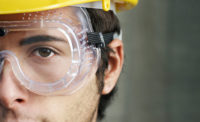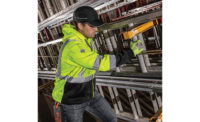Personal protective equipment (PPE) is the last line of protection for employees, after all feasible efforts are made to substitute or eliminate the known hazard at the source (engineering controls) and after safe procedures and rotation of employees (administrative controls) have been evaluated. PPE is used when there is a known hazard that cannot be removed or further reduced to a level of no concern and exists in a work area or assigned task to protect employees from the known hazard.
A reminder to all that there is no single type of PPE that can protect all individuals or protect one person from all known hazards. Therefore, the employer and employees must know what the hazard is that requires employee protection, what type of PPE is needed for that protection, what that specific PPE’s limitations are regarding providing that protection, and trained in its proper use, cleaning, and storage.
Hazard types can include: flying or air-suspended debris (eye, face, inhalation), dry (powder) and liquid substances (absorption, skin contact), falling materials or objects (head, feet), noise (ears), heat or cold (thermal for hands, body), slips/trips/falls (footwear, fall protection), and ionizing and non-ionizing radiation (eyes, skin), just to name a few. There are also specialty hazards from activities such as welding, entering confined spaces, and electrical work that all require specialty PPE.
Because of the variety of needs and specific selection of PPE, OSHA requires employers to conduct and document a risk assessment centered on hazards and the need for PPE when all other hierarchy options have been evaluated and taken. This document must be made readily available to an inspector, upon request, and is also part of ISO 45001 and VPP requirements. When there is a hazard, equipment, procedure, or a condition change, the risk assessment document must be updated to reflect the change.
Examples
Selecting eye protection is a common action taken by many, if not most, employers. The requirement to wear safety glasses with side shields when in active work areas is due to an existing, known hazard of the potential for flying debris, chips, or fragments striking someone from the routine processes or performed work in that work area. The limitation of that eye protection is based on it only protecting employees from flying solid particulates. If the employee’s task changes to involve using sprays or liquids, non-vented safety goggles would be selected to offer protection from the liquid(s), which is not provided by glasses. For air-suspended particles and fines, vented goggles would be the right choice.
Though selecting the right type of PPE is critical, there must also be consideration for comfort, proper fit, and function. If safety glasses are appropriate for the known hazard, finding glasses that fit well, that don’t obstruct peripheral vision, and provide a level of comfort rather than discomfort or pain are all part of the selection process. This will improve the use of the PPE by the employee and be less likely to cause other hazards or concerns that otherwise reduce the effectiveness of the appropriate PPE.
Footwear is another common PPE item. Selection is based on the existing hazard as to whether you need anti-slip soles, non-conductive for electrical work, steel-toe vs composite, etc. Other criteria include the type of material of the footwear – oil- or chemical-resistant, waterproof, insulated, or breathable as well as potential exposures to weighty falling or dropped objects, such as boxes, machine parts, packaging, or product.
For example, the highest rated toe protection is ASTM-75, based on when a 50-pound weight is dropped on the toe from a height of 18”, creating 75-foot-pounds of force. Heavier objects or falling from greater height may damage the toe cap. If there are heavier hazards, employees must be trained and aware of protecting themselves from the hazards since there is no greater level of protection in footwear. Of course, toe protection may not be necessary; employees may just need work boots that provide ankle support or non-slip soles.
It is the safety professional’s responsibility to know what PPE is needed and to stay current with changing technology. You should never chase “flavor-of-the-month” items as that just causes inventory nightmares and serious credibility concerns with your employees. Your selection must be based on quality, form/fit/function, and value-to-price. Do not ever select PPE on price alone. Foreign knock-offs are just that – knock-offs. Don’t buy junk.
Establish a good relationship with your safety distributor and get samples. Do not be unreasonable with a sample request. A single item or a half dozen of items to test is all you need to determine quality and value. With that request, price it, then compare.
PPE is necessary in most work locations since we cannot eliminate all known hazards. A proper risk assessment followed by smart choices will go far in both compliance and employee relationships.



